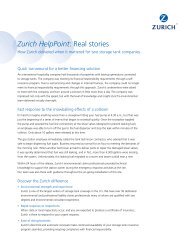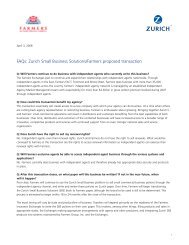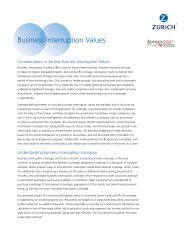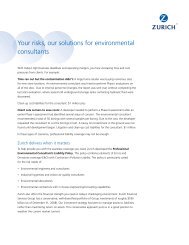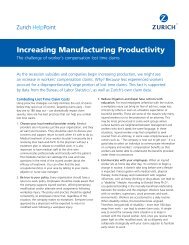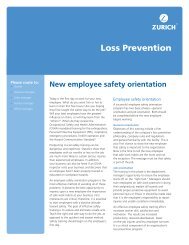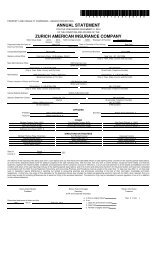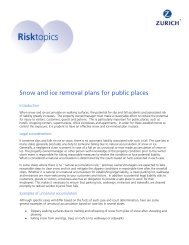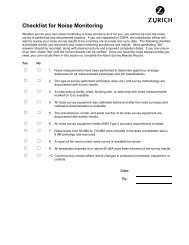Enterprise risk management: A critical tool for strategic ... - Lynch2
Enterprise risk management: A critical tool for strategic ... - Lynch2
Enterprise risk management: A critical tool for strategic ... - Lynch2
Create successful ePaper yourself
Turn your PDF publications into a flip-book with our unique Google optimized e-Paper software.
<strong>Enterprise</strong> <strong>risk</strong> <strong>management</strong>:A <strong>critical</strong> <strong>tool</strong> <strong>for</strong> <strong>strategic</strong>decision-makingDeciding what opportunities to fund,what <strong>risk</strong>s to protect
<strong>Enterprise</strong> <strong>risk</strong> <strong>management</strong>:A <strong>critical</strong> <strong>tool</strong> <strong>for</strong> <strong>strategic</strong> decision-makingArticle authorsLinda ConradDirector of Strategic Business RiskZurich Services CorporationChris YauSenior ManagerGlobal Products and Services Development, SGSTaking <strong>risk</strong>s is a necessary part of growing a business and adding stakeholdervalue. An organization that operates too cautiously and misses product or marketopportunities can have difficulty attracting the best talent and investor capital. Whilethe upside of <strong>risk</strong> is the ability to <strong>strategic</strong>ally seize business growth opportunities,today’s complex world has also revealed the downside of <strong>risk</strong>s. Fragile global supplychains, technology dependence, increased speed of product cycles, and complicatedfinancial models and relationships continue to multiply the breadth and depth of<strong>risk</strong>s facing organizations.Failure to either anticipate growth opportunities or plan <strong>for</strong> negative events canhave serious consequences on business operations, including loss of customers,inadequate asset protection, failure to meet regulatory requirements, lowerprofitability and share price. How can the senior <strong>management</strong> of an organizationbe more aware of their potential <strong>risk</strong>s—both the upside and downside? Recently,there has been an intensifying interest in enterprise <strong>risk</strong> <strong>management</strong>, or ERM, as a<strong>tool</strong> to enable organizations to consider the potential impact of all types of <strong>risk</strong>s ontheir processes, products, services, activities and stakeholders. In short, an effectiveERM approach can help an organization make the most efficient use of its capital.By determining what growth opportunities to fund, and what potential <strong>risk</strong>s needbudget support, an organization can better ensure it will meet its business objectivestoday and into the future.1<strong>Enterprise</strong> <strong>risk</strong> <strong>management</strong>: A <strong>critical</strong> <strong>tool</strong> <strong>for</strong> <strong>strategic</strong> decision-making
Regulatory and Legal Drivers of ERMEnhancing an organization’s growth opportunities, improving financial andoperational per<strong>for</strong>mance, and reducing losses are some of the internal drivers thatspark the development of an ERM framework within organization’s today. However,there are significant external drivers—primarily regulatory and legal—that arechallenging organizations to <strong>for</strong>malize their <strong>risk</strong> <strong>management</strong> processes. In short, it’sjust good business practice.In July 2009, the SEC proposed rules that would require <strong>management</strong> to increaseits disclosures of in<strong>for</strong>mation that describe the overall impact of compensationpolicies on <strong>risk</strong>-taking. The proposed rules would also require disclosure in a proxystatement about the board’s role in the company’s <strong>risk</strong> <strong>management</strong> process, and theeffect that this has on the way the company has organized its leadership structure.The SEC believes that disclosure should provide in<strong>for</strong>mation about how a companyperceives the role of its board and the relationship between the board and senior<strong>management</strong> in managing the <strong>risk</strong>s facing the company.At the same time, a bill was introduced in the U.S. House of Representatives thatwould require corporations to establish a <strong>risk</strong> <strong>management</strong> committee comprisedof independent directors. Additionally, the U.S. Treasury Department is consideringrequiring compensation committees of public financial institutions to disclosestrategies <strong>for</strong> aligning compensation with sound <strong>risk</strong> <strong>management</strong>.Ratings agencies and analysts have also taken a keener interest in governanceef<strong>for</strong>ts. In 2008, Standard and Poor’s (S&P) began assessing ERM processes as partof its corporate credit ratings analysis. Clearly, the need to create a robust ERMframework is something no corporate board or senior executive team can ignoretoday. Risk <strong>management</strong> has moved beyond just the purview of the CFO andaccounting department to become an enterprise-wide responsibility.In addition, the International Organization <strong>for</strong> Standardization (ISO) published theISO 31000:2009, Risk Management – Principles and Guidelines on November 15,2009. ISO 31000 provides generic guidelines intended to promote the adoption ofconsistent processes so as to ensure the <strong>risk</strong> is managed effectively, efficiently andcoherently across organizations.2<strong>Enterprise</strong> <strong>risk</strong> <strong>management</strong>: A <strong>critical</strong> <strong>tool</strong> <strong>for</strong> <strong>strategic</strong> decision-making
Less about Business Continuity, more aboutBusiness ResilienceRisk <strong>management</strong> is often used as a synonym with business continuity <strong>management</strong>.While the two processes share much in common and similar methods, they aredifferent concepts.Business continuity <strong>management</strong> deals with factors that may cause significantbusiness disruption or may damage the organizations’ reputation. It emphasizespreparing the organization <strong>for</strong> and bringing the organization back from athreatening event. In other words, business continuity <strong>management</strong> is an applicationof <strong>risk</strong> <strong>management</strong> in the context of threatening <strong>risk</strong>s and emphasizing a timelyrecovery after an incident.<strong>Enterprise</strong> <strong>risk</strong> <strong>management</strong>, on the other hand, sets down a structured framework<strong>for</strong> the organization to identify, rank, and control all the <strong>risk</strong>s concerned. The purposeof this broader assessment is to create a more resilient business—one that is betterprepared to adapt to changing conditions and leverage emerging opportunities, aswell as anticipate surprises and recover from disruptions. Effective enterprise <strong>risk</strong><strong>management</strong> goes hand in hand with a business resilience process by creating aproactive infrastructure <strong>for</strong> dealing with <strong>risk</strong>s systematically, holistically and successfully.360-Degree ERM Process Supports Strategic ObjectivesEffective <strong>risk</strong> <strong>management</strong> today requires an enterprise approach that views <strong>risk</strong> fromall angles – a <strong>strategic</strong>, 360-degree view supported by tactical, holistic solutions.Achieving this broad view ensures business resilience, reduces total cost of <strong>risk</strong>, andprotects profitability by improving a corporation’s ERM framework. An organizationwith a broader view of <strong>risk</strong> can better uncover and manage its business challenges,including operations and procedures, <strong>management</strong> styles and strategies, industryissues, emerging <strong>risk</strong>s and more.A 360-degree ERM process can help organizations meet these <strong>strategic</strong> objectives:• Protect the capital baseAn ERM review can potentially drive meaningful financial benefits includingreduced cost of servicing debt, improved access to capital and cost of capital.• Enhance value creation and contribute to optimal <strong>risk</strong>-return profileERM can increase probability of the upside and decrease the probability ofa downside.• Support corporate decision-making process <strong>for</strong> senior <strong>management</strong>, ERMcan demonstrate its incorporation of <strong>risk</strong> in<strong>for</strong>mation as a decision-makingprocess, especially <strong>for</strong> rated companies that need to score well on the S&PERM assessment.• Protect reputation and brand by promoting a sound culture of<strong>risk</strong> awarenessERM can increase investor confidence through proven <strong>management</strong>accountability <strong>for</strong> <strong>risk</strong>.3<strong>Enterprise</strong> <strong>risk</strong> <strong>management</strong>: A <strong>critical</strong> <strong>tool</strong> <strong>for</strong> <strong>strategic</strong> decision-making
ERM in ActionOver the past five years, Zurich’s operational <strong>risk</strong> capital efficiency has improvedthrough a strengthening of its ERM process, which includes the introduction of anoperational <strong>risk</strong> <strong>management</strong> framework. This framework provides Zurich with <strong>risk</strong><strong>management</strong> <strong>tool</strong>s to specifically identify, assess, manage and quantify operational<strong>risk</strong>s. Through this framework and the wider ERM process, Zurich increases its abilityto achieve efficiency and effectiveness gains. This allows Zurich to better focus onoptimizing company resources and in turn decide what opportunities to fund.For example, one business unit experienced a reduction of 21.7 percent inoperational <strong>risk</strong>-based capital consumption when Zurich moved from an asset-basedapproach to its current, <strong>risk</strong>-based approach <strong>for</strong> operational <strong>risk</strong> quantification. Thebusiness unit <strong>management</strong> then identified areas of high-<strong>risk</strong> exposure, per<strong>for</strong>med adeeper assessment and developed measures to mitigate the exposures. As a result,in the following year the unit experienced an additional reduction of 28.9 percent inoperational <strong>risk</strong> capital consumption. The operational <strong>risk</strong> capital not consumed wasthen available to fund profitable growth <strong>for</strong> Zurich.The Strategic Benefits of ERMThe benefits of developing a new ERM framework or improving upon an existing,more basic one include:• Minimizing barriers to achieving objectives and maximizing <strong>strategic</strong>growth opportunities• Reducing variability in expected business outcomes to enhance valuecreation advantage• Generating superior business intelligence to enable improved <strong>strategic</strong>decision making• Decreasing total cost of capital through optimizing the balance of <strong>risk</strong> and opportunity• Identifying key exposures, quantifying <strong>critical</strong> activity, and solidifying value chains• Demonstrating the benefit of increased <strong>risk</strong> transparency across your organization• Using additional <strong>risk</strong> in<strong>for</strong>mation to improve <strong>risk</strong> transfer and decreasenegative events• Protecting tangible and intangible assets to minimize impact on bottomline profitabilityClearly, managing <strong>risk</strong> can no longer be left to one person such as a Chief Risk Officeror siloed into one department, but demands a transparent approach to <strong>strategic</strong>decisions and daily operations. ERM can encourage resilience and help protectprofitability in an ever-changing business climate. Applied robustly across all areas ofan organization, a <strong>strategic</strong> ERM process will efficiently manage available capital---budgeting <strong>for</strong> potential <strong>risk</strong>s while funding the appropriate growth opportunities.4<strong>Enterprise</strong> <strong>risk</strong> <strong>management</strong>: A <strong>critical</strong> <strong>tool</strong> <strong>for</strong> <strong>strategic</strong> decision-making
A1-19286-A (08/10) 10-2690Zurich1400 American Lane, Schaumburg, Illinois 60196-1056800 382 2150 www.zurichna.comThe in<strong>for</strong>mation contained in this document represents the current view of the authors on the issues discussedas of the date of publication. Because the authors must respond to changing market conditions, it should notbe interpreted to be a commitment on the part of the authors, and the authors cannot guarantee the accuracyof any in<strong>for</strong>mation presented after the date of publication.This White Paper is <strong>for</strong> in<strong>for</strong>mational purposes only. The authors make no warranties, express, implied orstatutory, as to the in<strong>for</strong>mation in this document.Complying with all applicable copyright laws is the responsibility of the user. Without limiting the rights undercopyright, no part of this document may be reproduced, stored in or introduced into a retrieval system, ortransmitted in any <strong>for</strong>m or by any means (electronic, mechanical, photocopying, recording, or otherwise), or <strong>for</strong>any purpose, without the express written permission of SGS and Zurich Services Corporation.SGS may have patents, patent applications, trademarks, copyrights, or other intellectual property rightscovering subject matter in this document. Except as expressly provided in any written license agreement fromSGS and Zurich Services Corporation, the furnishing of this document does not give you any license to thesepatents, trademarks, copyrights, or other intellectual property.* For in<strong>for</strong>mation about the ratings of Zurich American Insurance Company, access the ratings section on www.zurichna.com. For more complete financial in<strong>for</strong>mation about the Zurich Financial Services Group and ratings<strong>for</strong> Zurich Insurance Company Ltd., access www.zurich.com



